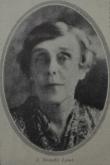Edith Beaufils Lamb was the daughter of 1860s Queensland MLA and pastoralist Edward William Lamb and his wife Julia (nee Fattorini). She was born in Sydney, but spent most of her early years on her parents' grazing property in Queensland.
Because of her delicate health, Lamb was educated at home. Nevertheless, she was one of the first typists employed in Sydney and the first woman to be employed by the Bank of New South Wales. She claimed she always wanted to write and started 'scribbling' when she was about ten years old. Her friends and family encouraged her, especially an aunt, but she believed it was her long-term companion, Mrs Robertson Keith, who gave her the most significant support.
Lamb's early poems were published in The Queenslander and The Echo. She stopped writing for a period but, with Mrs Keith's encouragement during their eleven-month stay in Scotland, commenced again during the war. Sir George Reid was also supportive and facilitated the publication of one of her poems in British Australian. It was Sir George who suggested she adopt her grandmother's name, Beaufils.
The emigrant and his or her problems was one of Lamb's recurring themes. She also wrote poetry about war and one of her poems, 'Who Rides To-Day?' was published at Easter, 1917, by the N.S.W. Recruiting Committee. Lamb raised funds for the war by writing poems that were set to familiar tunes. She was deeply patriotic, describing Australia as her 'religion' and holding strong beliefs about the need for Australia to be 'adequately populated'.
Bernice May describes Lamb as a 'woman's poet' who wrote for her own sex. She published poems in The Australian Woman's Mirror, many of which were about the mother and child.
Her companion, Mrs Keith, predeceased her and, at the time of May's article in 1928, she was 'any age from forty onwards' and was living alone in Turramurra, on Sydney's North Shore.
 2406572197161962481.jpg
2406572197161962481.jpg